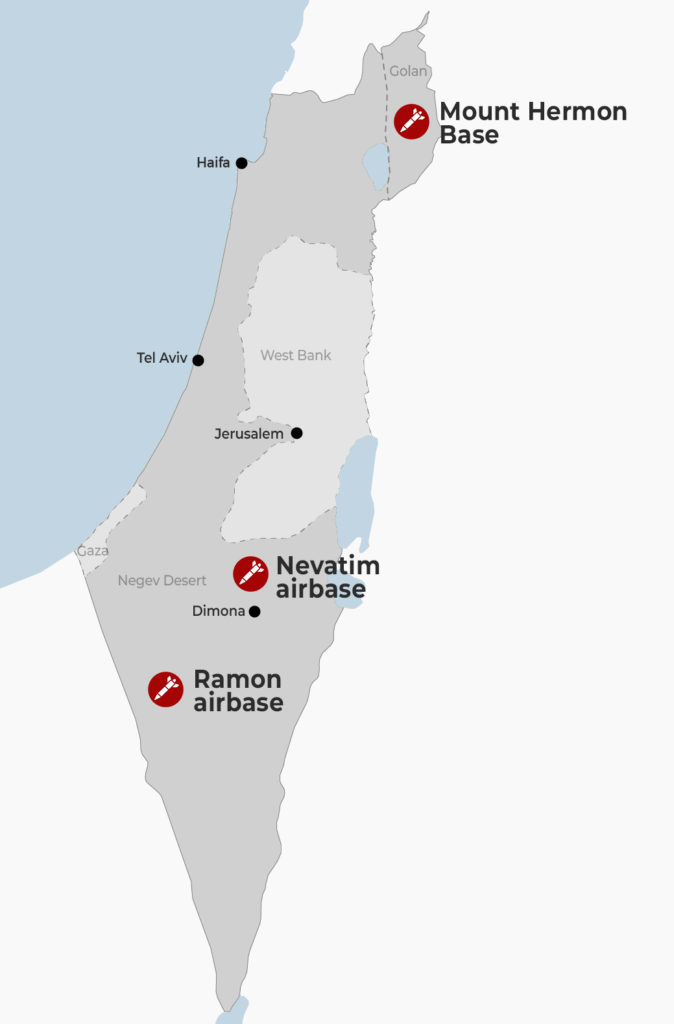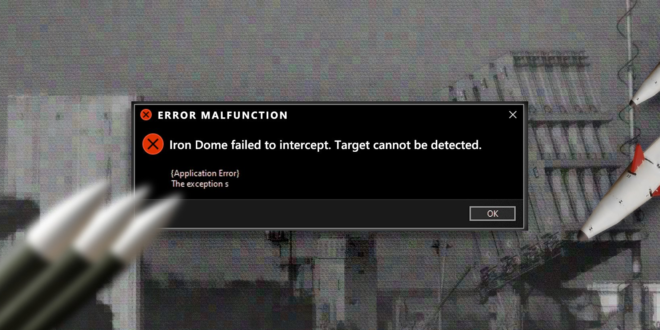Iran’s recent military strikes have exposed weaknesses in Israel’s ‘advanced’ air defense systems, overturning assumptions of their invulnerability while showcasing Tehran’s strategic pivot from ‘patience’ to ‘active deterrence.’
In the movie The Untouchables, there’s a scene where a member of the so-called “untouchables” federal investigative team is killed inside an elevator. The assassins leave a chilling message written in blood: “Touchable.”
This scene essentially mirrors a statement made by Iran’s Islamic Revolutionary Guard Corps Aerospace Force (IRGC/A) on 13–14 April, demonstrating that even well-guarded air defenses, like those of Israel and similar systems used by the US in the Persian Gulf, are, in fact, vulnerable.
Until now, the concept of “strategic patience” practiced by the Islamic Republic was often dismissed by its adversaries as mere rhetoric. However, Iran’s recent shift from passive to active deterrence showcases a strategic evolution that needs some context.
Strategic Patience and Grand Strategy
Tehran’s foreign policies today are underpinned by what is termed “political rationality,” a move away from the ideology-driven policies of the past. From this rationality, a comprehensive grand strategy emerges, utilizing all facets of state power – diplomatic, technological, industrial, economic, and military – to achieve Iran’s supreme political objectives.
This multifaceted grand strategy is shaped by several significant historical events that left an indelible mark on Tehran’s calculations. Firstly, the traumatic Iran–Iraq War (1980–1988) – commonly referred to in Iran as the “Imposed War” – that left deep scars from the sheer scale of brutality, including Iraq’s use of chemical weapons and the extensive urban and trench warfare that devastated both populations. Secondly, the post-2002 geopolitical scene defined by former US President George W. Bush’s “Axis of Evil” speech and subsequent aggressive postures towards Iran by US officials, which often portrayed the country as the foremost malign actor threatening global security.
The Iranians were existentially motivated to ‘never again’ endure the kind of vulnerability they experienced during the Iran–Iraq war. They resolved to achieve this on both military and strategic fronts. Step one was to develop a domestic armaments industry so that in the future, Iran could fight alone. Impressively, within a few decades, the country’s remarkable drone and missile programs were fully operational and stocked.
Strategically, Iran has aimed to keep conflicts away from its borders, adopting an “area denial” strategy, or what some would call establishing “strategic depth.” This strategy focused heavily on diplomacy and trade, soft power tools to engage positively with direct and far neighbors alike.
Strategic depth was also achieved in tandem with Iran’s military production goals, developing capabilities to neutralize threats at a distance, effectively denying enemy access within a 2,000-kilometer radius from central Iran through a combination of missiles, drones, electronic warfare, and air defenses.
The objective is to preemptively strike potential threats in the Red Sea and the eastern Mediterranean, deterring enemies before they can pose a direct threat to Iranian soil.
‘We’re ready now’
Iran’s IRGC, however, required considerable time to develop, test, and amass the desired stockpile of drones, missiles, and bombs within their subterranean ‘missile cities’ spread throughout Iran. The period of “strategic patience” in these past few decades was, therefore, crucial for Tehran, particularly in the Bush years.
But on 1 April 2024, the fruits of this preparation period became visible after Israel effectively declared war on Iran by targeting its consulate in Damascus.
In a recent post on X, Mahdi Mohammadi, a prominent Iranian defense official, stated: “For any rational actor, there is a point where cost-benefit calculations suddenly change, and strategies are re-written from scratch. For Iran, the Damascus attack was that point.”
In effect, Tehran was able to shift gears from “strategic patience” to “active deterrence” because the IRGC was finally ready.
Reconnaissance-in-force
Reports on drone and missile types launched by the IRGC are contradictory. Claims that hundreds of drones and missiles were launched are likely exaggerated. For Iran’s military objectives that night, employing “hundreds” of projectiles was simply unnecessary.
What is true is that the venerable Shahed-136 “suicide” drone was used, alongside possibly four medium-range ballistic missile (MRBM) models, in addition to the Paveh cruise missile. The targets, in order of importance, were as follows:
First was the Mount Hermon intelligence base in the occupied Golan Heights (33°19’00.3” N 35°48’ 22.6” E), which was struck by Paveh missiles – but given its desolate location, no images are available online.
Second was the Ramon Airbase (30°46’ 06.6” N 34°40’ 24.0” E). Given that it was a clear night, there is independent photographic and video evidence captured from different angles of manifold IRGC/A missiles striking the site.
Thirdly, the Nevatim Airbase (31°11’ 37.3” N 35°01’18.7” E), which Israel’s military admits sustained minor damage and has published some satellite imagery.

The IRGC/A raid, despite striking three pre-determined targets, was principally a reconnaissance-in-force (RIF), which is essentially a military tactic employed by an adversary to acquire intelligence using considerable – but not decisive – force.
Iran’s aerial raid compelled the Israelis to reveal both its strengths and weaknesses, which happens when air defense (AD) systems ‘light up’ their electronic sensors, activate electronic warfare (to jam or spoof missiles and drones), and launch interceptor missiles to down incoming targets.
It is common for Intelligence, Surveillance, and Reconnaissance (ISR) Unmanned Aerial Vehicles (UAV, or drones) to follow attack drones – while remaining at a distance – to monitor the battlefield and capture film, photographs, and electronic intelligence. If this was done, and ISR drones captured data despite intensive jamming efforts by the Israelis, it would allow the IRGC/A to develop a detailed map of Israeli air defense locations for future strikes.
Nonetheless, IRGC/A evidently had sound information on Israeli air defense capabilities and systems. Despite Israel and its allies (US, UK, France, and Jordan) already being on high alert that night, and rapid intelligence provided by reportedly Saudi Arabia and the UAE, the Iranian missiles successfully missiles struck all targets at Mount Hermon, Ramon, and Nevatim.
Israel’s defenses laid bare
The Israeli military has an integrated air defense system that includes the Iron Dome, Arrow, David’s Sling, Patriot, and more. This system is supplied with data from an advanced US radar system in Har Qeren, in the Negev Desert.
Its mission, as former UN weapons inspector Scott Ritter explained on X: “is to detect Iranian missile launches, and pass targeting data to Israeli Arrow and David’s Sling and US THAAD ABM batteries deployed to protect sensitive Israeli sites, including Dimona and the Nevatim and Ramon air bases.”
It is clear that Israel’s highly advanced system failed to protect Nevatim and Ramon. The latter is one of Israel’s largest air bases, and home to the top-line F-35l Adir fighter jets, stealth fighters, transport and tanker and recon aircraft, and Israel’s Air Force One, reserved for the country’s two top political leaders.
As such, Nevatim is defended by the world’s most advanced integrated anti-missile defense shield, specifically designed to protect against the Iranian missile threat.
The IRGC/A employed a strategic mix of drones as ‘bait’ and missiles with built-in countermeasures such as decoys and chaff to penetrate Israel’s air defense.
Despite the use of older MRBM models like Ghadr, Emad, and Dezful, alongside one of its newest and most advanced missiles, the Kheibar Shekan – and despite the limited number of missiles launched (reasonably approximated at 30–40 projectiles) – the majority of Iran’s missiles successfully reached their intended targets.
This occurred even as Israel and its allies launched hundreds of interceptors – at an estimated cost of $1.1 to $1.3 billion over the span of a few hours. But cost is the least of Tel Aviv’s problems: availability of replacement interceptors is, and will always remain, its chief concern.
This situation parallels challenges faced by Ukraine, which has depleted its air defense interceptors. A sustained campaign of raids by IRGC/A could similarly exhaust Israeli interceptor stocks, particularly if the US needs to conserve its own reserves.
US bases are on notice
The success of Iran’s Truthful Promise operation was partly due to Israel’s heightened alert, set into motion by Iran’s clever 72-hour warning to neighboring countries. Notably, members of the Axis of Resistance, like Yemen’s Ansarallah and Lebanon’s Hezbollah, did not participate in the attack, which was a strategic Iranian initiative as indicated by Leader Ali Khamenei’s statements that Israel “will be punished by our courageous men.”
Looking forward, the post-13 April implications for regional security are profound. If additional allied forces within the Axis of Resistance were to coordinate with IRGC/A in a prolonged offensive, the strain on Israel’s air defense system could be overwhelming.
If we think of Israel’s air defense coverage as a thick blanket that was penetrated by IRGC/A, then air defense coverage for US bases in Syria, Iraq, and the Persian Gulf states is a thin and tatty blanket. Any potential direct US conflict with Iran could expose US bases to severe attacks, with the possibility of these military sites being overrun and American troops being at great risk.
‘Touchable’ is Iran’s message
Iran’s aerial operation last weekend sent a clear message about the penetrability of sophisticated air defense systems, leading to significant concern among Israeli and US intelligence and military professionals.
The IRGC/A struck very precisely – and even had fun with IDF – when they dropped warheads into the officers’ swimming pool and recreation center at Nevatim. The message being: if you don’t dial back, we can do serious damage.
Whether this will translate into a strategic reassessment and earnest push towards de-escalation remains uncertain, despite the tactical ingenuity displayed by IRGC/A, which one American analyst described as a ‘masterpiece.’
 Eurasia Press & News
Eurasia Press & News


